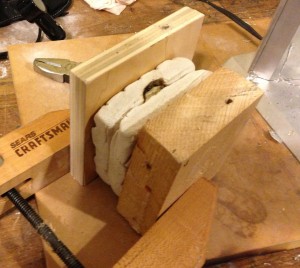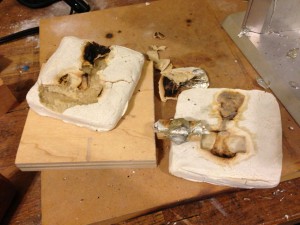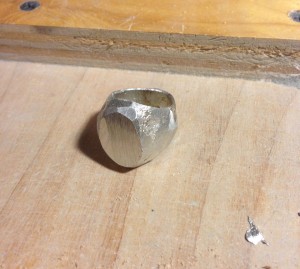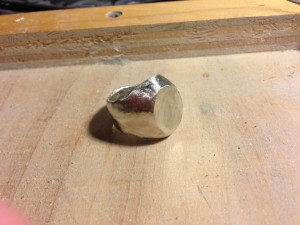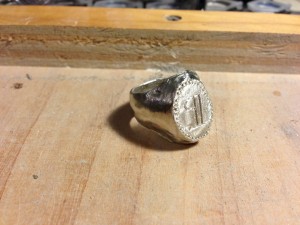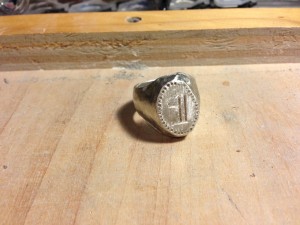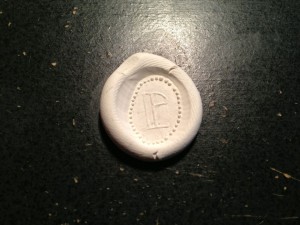When we last saw the mold for this project, it had just come out of the oven, firm but squishy in the middle. At this point I still needed to carve a sprue so I could pour the metal in. If I had done this when the dough was still wet, it probably would have worked fine. If I had waited until everything was bone dry, it probably would have worked fine. Instead, I had a dry shell with a doughy inside, which was not at all inclined to cut smoothly. I tore out a vaguely funnel shaped chunk and hoped for the best. Things were not looking good for the home team. The inside of the sprue looked awfully moist still, and I knew that moisture and hot metal did not go well together. How would I dry things out in there? Propane torch? Sure, why not?
So now I had a somewhat drier, charred mold that still was awfully squishy. Still no clue if it would work at all. I melted some pewter, put the spacer dowel into the cavity, held it together with a gloved hand and poured. All the metal poured right out the bottom. On the down side, things were clearly not lining up properly. On the up side, nothing had exploded!
Since the mold was still squishy, I figured I could squish the two halves together harder and close up the gap that was letting the metal run out. I clamped it between two pieces f wood and tried again. A little metal stayed in, but most of it still ran out the bottom. Clearly, the bottom of the mold was the problem area, so I moved the clamp down to the bottom edge of my boards:
Success! The metal stayed in and filled up my horrible excuse for a sprue. All I had to do now was pop the two halves apart and take out the first of many lovely castings.
Honestly, considering the utter lack of care and patience I put into this, I’m surprised things went this well. The mold was destroyed, but I had a vaguely ring-shaped lump of metal clinging to the dowel like a robotic kraken. Would I be able to salvage anything from it? I only had one chance to make something out of all this mess.
I clipped the tentacles off the mass of metal until I could knock the dowel free of its grip. Some time with the belt sander and various Dremel attachments allowed me to whittle it down into something fairly ring shaped. The face of the ring was sculpted as a circle, so you can see how much the mold had gotten squished during the casting process.
As I said earlier, I had never really done any sort of engraving. After all this work, I was hesitant to dive right in without any proper tools or clue what I was doing. I tinkered around with my made-from-a-screw graver, an awl, and a dental pick on the back of another stray casting to see how the tools worked. Unreliably, but well enough to give it a try. I scratched and scraped, buffed and polished, and started to see something like my monogram appearing. I ended up getting out one of the Dremel engraving burrs to get the etching deeper, then dragged the dental pick through the grooves again to give a less mechanical effect. I was just about happy with what I had until I realized that this was a seal matrix; the letters were supposed to be in reverse!
The belt sander made short work of my first attempt, and I used what I had learned the first time to make a second, larger rendition of the same design. A bit of punching with an awl around the border, and I had something passable:
So, would I try this mold method again? Maybe not for something this big. A smaller, thinner piece – especially one with a single sided mold – would probably work better, and dry faster. For a ring like this sand casting is probably a better option. As experiments go, though, this was not too bad. I ended up with a functional (if not perfect) piece, and learned a few things. Hopefully I’ll be able to sleep tonight without being woken up by any other bright ideas.

